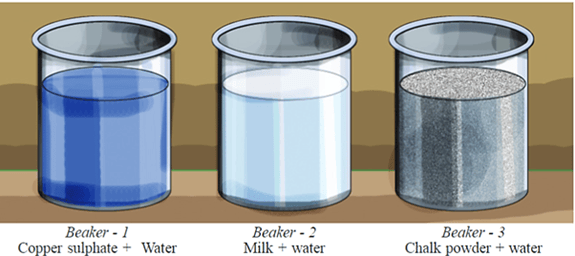Kerala Board Solutions for Chapter: Solutions, Exercise 7: Exercise 7
Kerala Board Science Solutions for Exercise - Kerala Board Solutions for Chapter: Solutions, Exercise 7: Exercise 7
Attempt the practice questions on Chapter 4: Solutions, Exercise 7: Exercise 7 with hints and solutions to strengthen your understanding. Science for Class 8 - Part 2 solutions are prepared by Experienced Embibe Experts.
Questions from Kerala Board Solutions for Chapter: Solutions, Exercise 7: Exercise 7 with Hints & Solutions
Let's do an experiment. Take equal amounts of water in three separate beakers. Add copper sulphate crystals in the first, milk in the second and chalk powder in the third beaker. Stir them well. Keep the beakers undisturbed for some time.

In which of these beakers did the substance settle down?
Let's do an experiment. Take equal amounts of water in three separate beakers. Add copper sulphate crystals in the first, milk in the second and chalk powder in the third beaker.

What will you observe if an intense beam of light is passed through the sides of the three beakers? Write your answers in Yes/No in the following table.
| Observation | Beaker- | Beaker- | Beaker- |
| The path of the beam can be observed | |||
| Particles can be observed |
Beaker contains a true solution, beaker contains a colloid and Beaker contains a suspension. Tabulate the characteristics of each mixture in the following table.
| Activity | Solution | Colloid | Suspension |
| Filtering using a filter paper | Particles can not be separated by filtration | _____ | _____ |
| Passing an intense beam of light | The path of the light beam is not visible | The path of the light beam is visible | _____ |
| Keep it undisturbed | _____ | _____ | Particles settle down |
Beaker - contains a true solution. Beaker- contains a colloid and Beaker - contains a suspension. Which mixture in these beakers has the smallest particle size? How was this identified?
Beaker - contains a true solution. Beaker - contains a colloid and Beaker - contains a suspension. Which mixture in these beakers has the biggest particle size?
Evaluate the following mixtures: Ink, muddy water, fog, atmospheric air, milk, sugar solution, dilute rice water. Classify them into true solution, colloid and suspension.
Have you noticed that the path of the light beam can be clearly seen due to the dust particles in a cinema theatre and in smart classrooms where visuals are shown using a projector? What is the reason behind this?
Tabulate the mixtures that we use in our daily life into solutions, colloids and suspensions. Are colloids and suspensions homogeneous mixtures?
